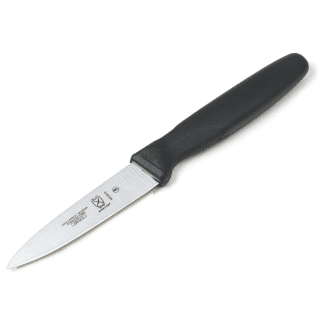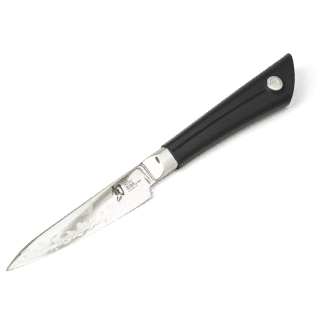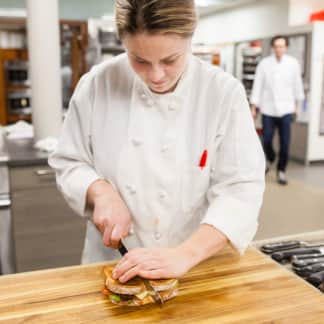A good paring knife is a small but mighty addition to any knife collection. Its diminutive size makes it more maneuverable and better able to hug curves than bigger knives. We choose a paring knife over a chef’s knife for three primary tasks where control is paramount. One: poking things without stabbing too widely or deeply, as when scoring chicken skin to help the fat render, piercing boiled potatoes to gauge doneness, or nipping into salmon fillets to see if they’re cooked through. Two: surgical incisions, such as splitting open dates to fill with blue cheese, slicing pockets into pork chops to stuff them with herbs and cheese, hulling strawberries, or coring tomatoes. And three: peeling fruits and vegetables such as apples, oranges, or stubborn celery root (whose skin is too tough for a peeler).
To find the best paring knife, we tested eight models, including our previous winner from Wüsthof and our previous Best Buy from Victorinox. We limited our testing to knives with blades 3 to 4 inches long, as we know from past testing that shorter blades can’t reach through the food and longer blades are difficult to control.
First off, all the knives we tested were at least decent. We favored one knife that excelled at every task we threw at it, but I’d bet you $100.00 that if you stopped a stranger on the street and asked them to choose one of the knives we tested to take home, they would choose the wrong one. That’s because—there’s no other way to say it—our winning paring knife looks cheap. And it is cheap, selling for less than $10.00. It’s light and small with a plastic handle and none of the heft, snazzy looks, or authoritative air some of the other knives have. But it was the best performer nonetheless.

What separated this small, unassuming blade from the pack? For one, the slight, no-frills plastic handle was comfortable, a quality that might be more important for a paring knife than for any other knife. That’s because, unlike chef’s knives, paring knives are often used in the air, off a cutting board: You hold a strawberry in one hand and hull it with the knife held in your other hand. Thus, using a paring knife requires the user to cut in different directions on different planes, swerving this way and that around, say, bumps on a piece of ginger root or the curved exterior of an orange. When we made these cuts with heavier paring knives or with those that had larger handles, our hands got tired. Fatigue wasn’t an issue with our light, slim winner.
We also liked its blade, which was sharp and felt particularly smooth in use: “I’m not pushing, just guiding,” said one tester. All of the knives were sharp out of the box; a few were less so at the end of testing, possibly due to the lower quality of their metal. Sharp knives are easy to work with and safe—the risk of injury increases when using a dull blade because you have to push harder than you would with a sharp blade.

A few other factors made some knives easier to work with than others. One was flexibility; with a chef’s knife a firm, rigid blade inspires confidence, but with a paring knife you want some flex so the blade can worm its way into tight spaces or conform to curves for cleaner cuts. Knives with stiffer blades were harder to turn and took off a bit more fruit with their peels.
Spine thickness also had an impact on our preferences. The spine is the top of the blade, opposite the sharp edge. When peeling apples and oranges, we noticed that knives with thicker spines, around 1.5 millimeters, felt duller because we had to pull more metal through the fruit than we did with knives with slimmer spines of about 1.3 millimeters or less.
Finally, tips matter with paring knives. You use the tip of a paring knife a lot, and we preferred those with pointy, sharp tips. One knife had a notably dull, rounded tip, and it cored strawberries like a shovel.
Our favorite paring knife is a stellar, inexpensive performer.The Victorinox Swiss Classic Spear Point Paring Knife has a razor-sharp, nimble blade: “I feel like I’m splitting cells,” said one tester. “I think it’s giving me better knife skills.” And it has a grippy plastic handle that's easy and comfortable to hold even when it gets wet.
The Tests:
- Test initial sharpness by slicing copy paper
- Slice cheddar cheese
- Peel and slice fresh ginger
- Peel, quarter, and core apples
- Section oranges
- Hull strawberries
- Have multiple users test and evaluate
- Test final sharpness by slicing copy paper
How We Rated:
- Comfort: We rated the knives on how secure and comfortable they felt, as well as how their working weight impacted performance.
- Sharpness: We rated each knife on sharpness when it was brand-new, as well as after each test. We conducted a final paper sharpness test at the conclusion of testing and rated the knives accordingly.
- Agility: We evaluated the knives on balance, length, and shape.





















